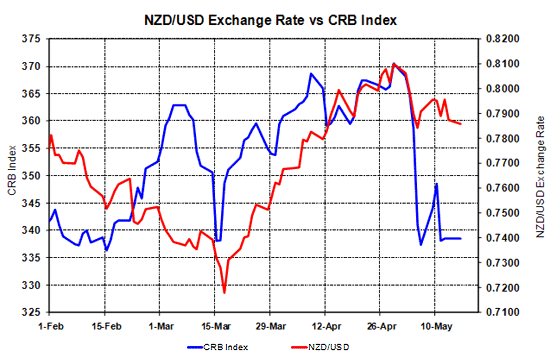

By Roger J Kerr
The 'End of the Golden Weather' is a classic Kiwi beach story and as we move into the month of May after an extended Indian summer in Auckland, it feels that the weather is turning and that the golden run for commodity markets (and thus the Kiwi dollar) may be coming to the end of their extended season.
The extreme short-term volatility up and down in global commodity prices over recent weeks signals to me that the strong uptrend is nearing its end as the market participants cannot decide whether to buy or sell to get on the next trend.
Such wild daily swings are often a signal that a major trend is coming to an end.
What we may also be seeing is higher volumes of price hedging by the producers of commodities as they lock into the massive price gains, thus corporate profitability.
An article on the commodity markets in last week’s Economist magazine highlighted the imbalances and bubbles that have arise from the US exporting their loose monetary policy, super low interest rates and weak currency to emerging market economies who tie their currencies to the USD currency. These financial conditions have added to the boom in commodity prices and caused the resultant food price inflation worries for central banks around the world and similar worries for Middle-Eastern dictators, as it was food price increases that originally sparked the pro-democracy movements.
The Economist cynically (and correctly) proffered that it was no coincidence that Swiss commodity trading house Glencore launched their IPO at the top of the commodity curve and with a frothy share price to boot.
Their timing to sell their own shares to unsuspecting punters and cash-out at the top of the commodity cycle tells you something about risk/reward on these markets from here.
As has been stated in this column repeatedly for the last six months is that the tightening of monetary policy in China must be a negative for commodity prices, as the pace of Chinese demand and economic growth is slowed just a fraction. To date we have not really seen the tightening of credit and higher interest rates in China dent the commodity price increases.
However, the change in monetary conditions may finally be starting to have an impact as recent Chinese economic data has not printed as strong as prior forecasts.
There is no question that Chinese demand from the massive industrialisation, infrastructure build and urbanisation has caused a fundamental and paradigm shift upwards in commodity prices in recent years. However, that structural increase in prices does not remove the cyclicality of commodity markets.
The current higher prices will attract producer hedging (selling) and increased production which increases supply to meet the demand.
The long-term trend is still upwards for commodities (which is very good news for the NZ economy), however a significant short/medium term correction back in prices now looks much more likely. The implications for the NZD/USD exchange rate are therefore back towards 0.7000 over coming months, but firmly back up on rising NZ interest rates and commodity markets getting back on their uptrend in 2012.
As the chart below signals, the NZD/USD exchange rate has not depreciated as much as commodity prices over recent weeks.
It appears overdue, in the short-term to catch up to the commodity price declines.

No chart with that title exists.

We welcome your comments below. If you are not already registered, please register to comment
Remember we welcome robust, respectful and insightful debate. We don't welcome abusive or defamatory comments and will de-register those repeatedly making such comments. Our current comment policy is here.